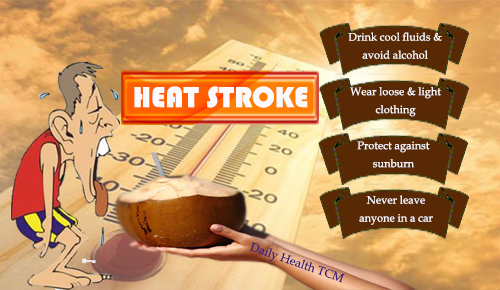What is Heat Stroke?
Heat stroke or heat shock is a disease associated with a very serious heat (Heat Illness Extraordinary). It is a life-threatening medical emergency resulting from a failure of regulation of body temperature (thermoregulation). Unlike other heat illness, heat stroke is characterized by extreme elevation of body temperature (hyperthermia) and related dysfunction of the central nervous system and organ failure.
Heat stroke often occurs as a progression from milder heat-related illness such as heat cramps, heat syncope (fainting), and heat exhaustion. But it can strike even if people have no previous signs of heat injury.
Typically, the process of sweating and facilitate sweat evaporation cooling of the body. In extreme temperature that exceed 90°F (32.2°C), the amount of heat generated exceeds the cooling effect of evaporation of sweat. Similarly, if the humidity reaches 100%, evaporation of sweat is no longer possible, and the body loses its ability to reduce the heat. Finally, increased body temperature, leading to a dehydration severe and may lead to death.
Complications or severe condition that can occur due to the complex problems related to heat are:
- Conditions are too severe can cause dehydration (drought)
- Confusion, and coma (unconsciousness)
- Swelling of brain tissue
- Damage to body organs such as kidney, heart and liver
- Heat stroke can cause the death
Risk Factors for Heat Stroke
Everyone is at risk of heat-related health problems. In general, prolonged exposure to temperature above 90°F (32.2°C) or humidity above 60% the risk of heat-related illness. However, certain groups are more at risk for health effects. These groups include:
- Children aged 5 and under
- People suffering from respiratory and heart
- People suffering from high blood pressure, diabetes and disease of the thyroid glands
- They were involved in activities such as physical activity of workers, farmers, athletes, soldiers and others
- Adults (people aged 40 years and older is 10 times more at risk than younger people)
- The risk increase if they wear a thick and tight preventing heat out of the evaporation / drying sweat
Heatstroke Symptoms
- High body temperature.
- Altered mental state or behavior.
- Alteration in sweating.
- Nausea and vomiting. .
- Flushed skin.
- Rapid breathing.
- Racing heart rate.
- Headache.
Prevention
When the weather is extreme heat :
- Limit outdoor activities
- Wear a hat or large umbrella
- Drink plenty of fluids, regardless of your activity level
- Take frequent breaks in the shade and cool
- Bathroom fan or open to breathtaking body
- Located in a sheltered spot, such as in home / building
- Wear lightweight, light-colored and loose-fitting
- Use clothing made of cotton and use sunscreen lotion
- Drinking isotonic drinks or coconut water because it can replace the salt and minerals lost during sweating
Prohibition
Avoid extreme hot weather of :
- Drink beverages containing caffeine, alcohol, or large amount of sugar
- Do not allow yourself to thirst and the body of water shortage
- Avoid being in the open when the weather is hot
- Letting someone in the car with tight lids
- Exercise and activity in a hot environment
Treatment
How to overcome the problems and dangers due to hot weather
- Get help if the situation can not be controlled
- Place the cloth wet and cold on the body
- Hot air out of the area
- Remove tight clothing
- Drink water every 15 minutes
- Get out of the heat
- Avoid vigorous physical activity for a while

